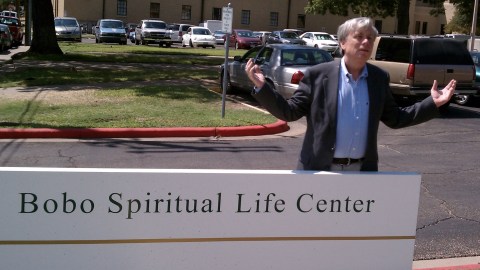Colorado’s Conservative Affirmative-Action Scheme

So the University of Colorado has hired my friend Steve Hayward to be a visiting professor in conservative thought and policy. Some alum’ funded the position because he believed that students had no conservative voice from which they could learn the truth about what conservatives think.
Steve is a thoughtful, fascinating, and erudite guy. The students will get a lot out of having him around.
Still, conservative Max Boot wonders whether this is the right way to get the “right voice” on campus.
For one thing: Is this the worst form of tokenism? Won’t the university wrongly believe it’s become so inclusive that its big tent now even includes conservatives? The real problem is that there are hardly any conservative being hired in the various disciplines that make up the social sciences and humanities. Surely a genuinely open-minded place would sometimes hire scholars for their academic credentials who just “happen” to be conservative. But we don’t see that going on in our elite institutions.
It might be no accident, as they say, that you find more conservative professors of physics and engineering than conservative professors of literature or history. The standards in the hard sciences are more objective, those in the soft sciences and the humanities more ideological.
Here’s another problem: Intentionally bringing a conservative in because just he’s a conservative—a kind of affirmative action—begs the question of just what does it mean—from a scholarly or public-philosophical view—to be a conservative. The conservative “brand” is used very loosely in political life, and that’s fine. But it turns out that what it means to be a conservative is an intense bone of contention among conservative scholars and intellectuals.
Being a conservative is a pretty indefinite category. It’s not like being Hispanic or being African American or being a woman. So when a university says (rightly or wrong) for reasons of intellectual diversity it needs a “critical mass” of African Americans, it thinks it pretty much knows exactly what it’s looking for.
But you (especially if you’re a conservative) might respond: Race-based affirmative action to achieve intellectual diversity never really made sense. (Affirmative action to achieve racial justice—or real equality—is a completely different issue.) There’s no reliable guarantee that skin color predicts opinion. And it’s paternalistic—not to mention contrary to the First Amendment—to insist that black faculty represent what are regarded as characteristically black opinions. The opinions of Clarence Thomas are deeply rooted in his experience as a black American, but everyone knows that getting his opinions on campus is not what the diversity people have in mind.
Steve, by contrast, is being hired because he clearly does well in representing conservative opinions. The diversity he represents isn’t an accident of birth, but the product of conclusions reach by his free mind.
Still, what about the conservatives who don’t think Steve’s really a conservative? The most famous attempt to “brand” American conservatism with definite philosophical and literary credentials was Russell Kirk’s The Conservative Mind. But Steve’s outstanding scholarly mentor, Harry Jaffa, spent a lot of his life trying to discredit Kirk’s brand of conservatism as not really conservative and not really American.
Some Kirkians, meanwhile, call “Straussians” such as Jaffa and Hayward “Jacobins”—or French and revolutionary or the opposite of conservative. Steve is quite comfortable with bragging that he’s all about conserving the American, revolutionary, natural-rights tradition. For the Kirkians, revolutionary tradition is an obvious oxymoron.
If you’re suspecting I could go on and on, you’d be right. But I’ll settle for one more example: Some conservatives (including many Kirkians) have a very traditionalist concern for the primacy of devotion to a particular place over abstract principle. That leads them to be pro-Agrarian and anti-industrial. They often end up thinking that techno-America is a wasteland that grows, and so they become environmentalists in the mode of the novelist Wendell Berry. (I refer you to the webzine The Front Porch Republic.) But Steve joins the libertarians in being quite skeptical of all “environmentalist” public-policy claims, and he has a corresponding faith in American technology as part of our proud tradition of devotion to individual rights and individual ingenuity.
So does that mean Steve is a libertarian, and that conservatives aren’t libertarians? Well, I agree there is a big distinction between being a conservative and being a libertarian. And someone who holds a chair in conservatism shouldn’t be a libertarian. The most consistent libertarians, like Ronald Bailey, are closer to BIG THINK transhumanism than Kirkian traditionalism.
But Steve doesn’t hold a Randian belief that human beings should be evaluated only according to their creative productivity. He’s also big on the study of philosophy and the thought of the American Founders and all that for their own sake. But that doesn’t mean that his view of the “content” of liberal education is the same as that of many or most conservatives. Steve is all for “Great Books” education, but some conservatives, such as Pat Deneen, think that the effect of studying those books outside of their theological-traditional context is relativism, an education about great questions that don’t have any particular great answers. And relativism—or indifference to the truth about who we are and what we’re supposed to do—isn’t conservatism. But Steve counters that respecting philosophy and being convinced of the truth of the American proposition are his effective antidotes to the relativistic temptation.
So here are my great questions: Does a professor of conservatism represent himself, or does he represent being a conservative in a more general sense? Can he teach what he really thinks or believes, or does he have to represent all or some of the various and conflicting kinds of conservatism in America? Is he the diversity, or is a representative of conservative diversity?




